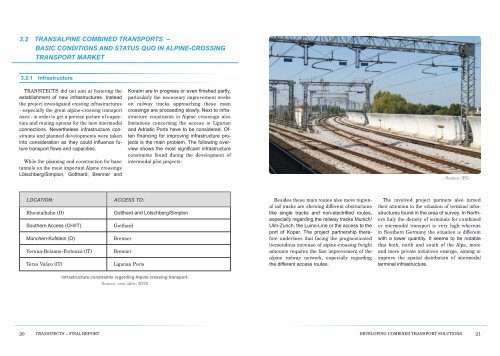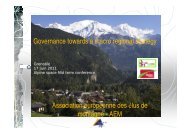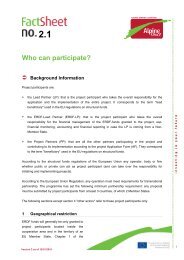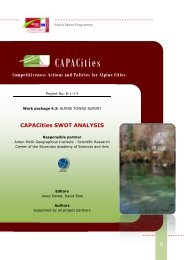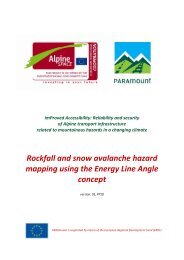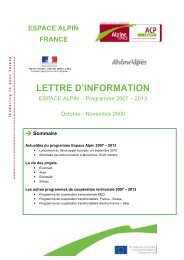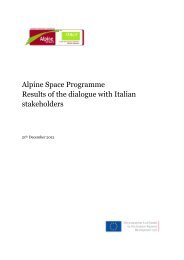intermodal solutions for transalpine freight traffic - Alpine Space ...
intermodal solutions for transalpine freight traffic - Alpine Space ...
intermodal solutions for transalpine freight traffic - Alpine Space ...
Create successful ePaper yourself
Turn your PDF publications into a flip-book with our unique Google optimized e-Paper software.
3.2 <strong>transalpine</strong> combined transports –<br />
basic conditions and status quo in alpine-crossing<br />
transport market<br />
3.2.1 Infrastructure<br />
TRANSITECTS did not aim at fostering the<br />
establishment of new infrastructures. Instead<br />
the project investigated existing infrastructures<br />
- especially the great alpine-crossing transport<br />
axes - in order to get a precise picture of capacities<br />
and routing options <strong>for</strong> the new <strong>intermodal</strong><br />
connections. Nevertheless infrastructure constraints<br />
and planned developments were taken<br />
into consideration as they could influence future<br />
transport flows and capacities.<br />
While the planning and construction <strong>for</strong> base<br />
tunnels on the most important <strong>Alpine</strong> crossings<br />
Lötschberg/Simplon, Gotthard, Brenner and<br />
Koralm are in progress or even finished partly,<br />
particularly the necessary improvement works<br />
on railway tracks approaching these main<br />
crossings are proceeding slowly. Next to infrastructure<br />
constraints in <strong>Alpine</strong> crossings also<br />
limitations concerning the access to Ligurian<br />
and Adriatic Ports have to be considered. Often<br />
financing <strong>for</strong> improving infrastructure projects<br />
is the main problem. The following overview<br />
shows the most significant infrastructure<br />
constraints found during the development of<br />
<strong>intermodal</strong> pilot projects:<br />
Source: IPG<br />
location:<br />
Rheintalbahn (D)<br />
Southern Access (CH/IT)<br />
München-Kufstein (D)<br />
Verona-Bolzano-Fortezza (IT)<br />
Terzo Valico (IT)<br />
access to:<br />
Gotthard and Lötschberg/Simplon<br />
Gotthard<br />
Brenner<br />
Brenner<br />
Ligurian Ports<br />
Besides these main routes also more regional<br />
rail tracks are showing different obstructions<br />
like single tracks and non-electrified routes,<br />
especially regarding the railway tracks Munich/<br />
Ulm-Zurich, the Luino-Line or the access to the<br />
port of Koper. The project partnership there<strong>for</strong>e<br />
underlines that facing the prognosticated<br />
tremendous increase of alpine-crossing <strong>freight</strong><br />
amounts requires the fast improvement of the<br />
alpine railway network, especially regarding<br />
the different access routes.<br />
The involved project partners also turned<br />
their attention to the situation of terminal infrastructures<br />
found in the area of survey. In Northern<br />
Italy the density of terminals <strong>for</strong> combined<br />
or <strong>intermodal</strong> transport is very high whereas<br />
in Southern Germany the situation is different<br />
with a lower quantity. It seems to be notable<br />
that both, north and south of the Alps, more<br />
and more private initiatives emerge, aiming to<br />
improve the spatial distribution of <strong>intermodal</strong><br />
terminal infrastructure.<br />
Infrastructure constraints regarding <strong>Alpine</strong> crossing transport.<br />
Source: own table, RVDI<br />
20<br />
transitects – final report<br />
DEVELOPING COMBINED TRANSPORT SOLUTIONS 21


